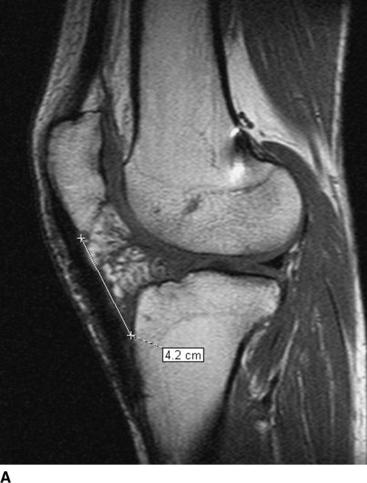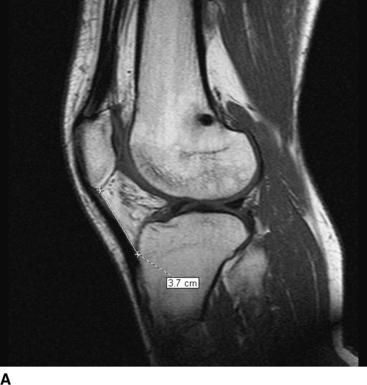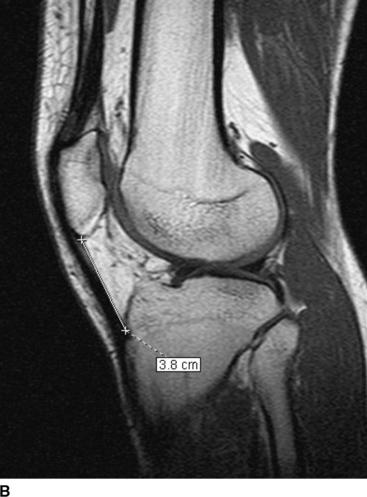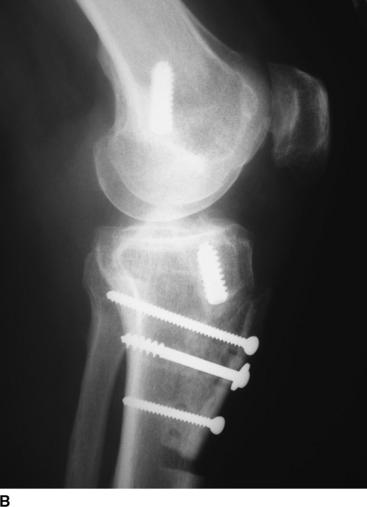Chapter 79 Anterior Knee Problems After Anterior Cruciate Ligament Reconstruction
Anterior Knee Problems Related To the Graft
Patellar Tendon and Hamstring Tendon Autografts
The impact of patellar tendon graft harvesting on knee symptoms is well documented. An increased incidence of anterior knee problems such as pain and loss of sensitivity was found in patients in whom a patellar tendon autograft was harvested from the “healthy” contralateral knee, and therefore this procedure should be avoided because additional problems and morbidity are transferred onto the healthy contralateral knee.1
The gold standard thus far for ACL reconstruction is the mid-third bone–patellar tendon–bone (BPTB) autograft. However, it has been associated with significant (in 40% to 60% of patients) anterior knee symptoms,2–7 and therefore the use of four-strand hamstring tendon graft is increasing in popularity because these problems seem to be less frequent.
In the literature, results are conflicting in the comparison of the two most popular grafts (patellar and hamstring tendon) regarding the incidence of anterior knee pain.8–10
However, three meta-analyses concluded that ACL reconstructed knees with patellar tendon are more prone to developing anterior knee symptoms and extension deficit than the hamstring tendon group.11–13
In a study with a long-term follow-up,7 kneeling pain was found to persist even at 7 years postoperatively and was more common and more severe in the patellar tendon group (54%) than the hamstring tendon group (20%). Similarly, the incidence of donor site symptoms in any form was more than doubled in the patellar tendon group compared with the hamstring tendon group, and the incidence of extension deficit increased over time in the patellar tendon group, probably secondary to development of osteoarthritic changes.7
But what causes anterior knee problems after patellar tendon harvest?
Harvesting trauma, patellar tendonitis, tendon changes during the repair process of the tendon gap, vascular damage of the retropatellar fat pad, and proprioceptive loss of the extension mechanism are all possible causes.14 Patellar tendon shortening is another important factor for development of anterior knee pain. It has been demonstrated with a magnetic resonance imaging (MRI) study15 that significant patellar tendon shortening (with a mean of 9.7%) occurs after harvesting BPTB graft compared with the contralateral nonoperated control knee 1 year after ACL reconstruction (Fig. 79-1).
In contrast, harvesting of hamstring tendons resulted in a nonsignificant shortening of the patellar tendon of 2.6% (Fig. 79-2). Using an Insall-Salvati ratio less than 0.74 as the MRI criterion for patella baja diagnosis,16 12.5% of the patients in the BPTB group and 3% in the hamstring group were found to develop patella baja after surgery. This shortening was not of clinical importance, as it was not associated with anterior knee pain in the short-term follow-up. However, one other study with longer follow-up (average 7 years) has clearly shown that severity of patellofemoral joint arthritis and anterior knee symptoms correlate with the amount of patellar tendon shortening17 (Fig. 79-3).
Central patellar tendon harvesting has been found to cause a slight medial displacement of the patella,18 and this alteration in position causes high contact forces in the medial patellofemoral joint.14 A solution to this may be the use of the medial third of the patellar tendon, which does not influence the patellofemoral angle and causes an insignificant lateral patellar displacement.18
Anterior knee pain does occur after hamstring ACL reconstruction, despite the fact that the anterior structures of the knee remain intact. The reason for this is not clear, but it is known that the patellofemoral joint can be the source of pain after almost any surgery to the knee, even if the patellofemoral extension mechanism is not directly involved. The incidence of anterior knee pain after hamstring graft for ACL reconstruction in the literature is less than 23%.19–22 Evaluation of the pain with diagrams has shown that it is more diffuse and is not related to the skin incision for tendon harvesting or tibial tunnel drilling.19 In contrast, anterior knee pain after patellar tendon harvesting is more well localized, and palpation reveals trigger points that are usually over the inferior pole of the patella or the tibial tuberosity or above the patellar tendon donor site.14,23
There are conflicting reports in the literature on whether grafting the patella and tibial tunnel bone defects after BPTB harvesting reduces23,24 or does not reduce25 the incidence of anterior knee symptoms. There is also a report that patella grafting increases the incidence of painful spurs at the inferior pole of the patella.26 Similar arguments exist regarding whether suturing the patellar tendon gap facilitates tendon healing or is a cause of patellar tendon shortening.27 Patellar fracture is another important issue unique in BPTB grafts, and its incidence varies from 0.2%28 to 2.3%.29
Patellar tendon rupture is another rare complication that may occur after patellar tendon harvest. Devascularization and an alteration in tendon healing and remodeling are possible causes of this complication.30
Central Quadriceps Tendon
In a recent study, less than 10% of patients with quadriceps tendon graft suffered anterior knee pain in various activities, and only 6% complained of kneeling pain.31 Donor site irritation over the proximal patellar border was observed in several patients but did not last more than 6 months, and quadriceps strength 1 year postoperatively was comparable with that of other autografts in the literature.31 The risk of patellar fracture must be lower than that of patellar tendon graft because the bone in the proximal patellar pole is more dense.32 Injury of infrapatellar branches of the saphenous nerve is not a problem because the incision does not cross them.













